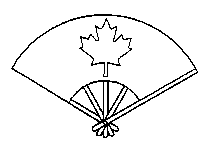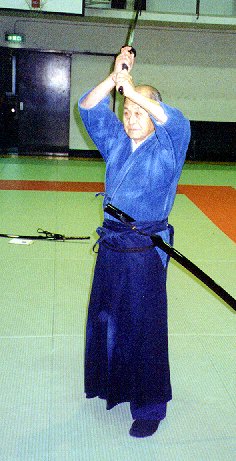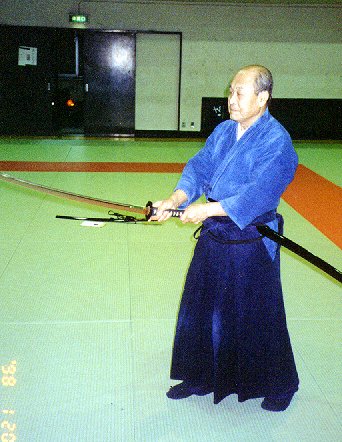Journal of Japanese Sword Arts
A monthly magazine dealing with all aspects of Japanese sword study.
Subscribing to the Journal of Japanese Sword Arts
Issue: #89 Feb. 1998
|

Journal of
Japanese Sword
Arts
A monthly journal concerning all aspects of
the use of the Japanese Sword. Articles,
news, reviews, technical tips.
$36 cdn in Canada per year
$36 US in USA
$48 overseas.
JJSA
Kim Taylor, ed.
44 Inkerman St.
Guelph Ontario
Canada, N1H 3C5 |
OHMI JINGU ENBU
January 3, 1998
by Peter Boylan, Shiga-ken Japan
Shogatsu, or New Year's, is the biggest holiday in Japan. Everyone visits their local shines and
temples to greet the kami and pray for a good year. It is also popular to visit famous shines and
temples as well. The really famous shrines and temples turn into mad-houses, filled with
crowds jostling to get to the front of the temple to make a New Year's offering and say a prayer.
In Shiga Prefecture, right next to Kyoto, one of the major shrines, Ohmi Jingu, has a big festival
on the third day of the New Year, the last day of the Shogatsu holiday. The Shiga Prefecture
Kendo Renmei takes part in this festival every year by performing Iaido in front of the main hall
of the shrine as an offering to the Kami of Ohmi Jingu. There is an open, white gravel garden
separating the area for making offerings and prayers from the honden, the building where the
Kami resides, and we demonstrated there.


Before we could demonstrate, we had to go through a Shinto purification ritual. All of the
participants in the demonstration, who ranged from mudansha up to hachidan, filed into the ante
chamber of the honden, and the priest chanted in very, very formal Japanese (which of course, I
couldn't understand), and a female assistant told us to bow our heads in the appropriate places.
After this the priest waved sasaki leaves and a wand with cut rice paper over us to purify us.
Finally, Kojima Sensei, hachidan, Tsuda Sensei, nanadan, and Inoue Sensei, Nanadan, made
offerings of sasaki leaves to the Kami as representatives of our group.
One of the miko, or shrine maidens, directed us out a door opposite the one we had come in, and
as we filed out that door and down some steps, we were each given a small cup of sake to drink
to further purify ourselves. We got to keep the cup as a souvenir.
Now the enbu began. There were approximately forty people taking part, and the first thing we
did was take a group picture on the steps of the honden. Kojima Sensei embarrassed somebody's
wife by making her come up on the steps with her kids to be in the picture. She couldn't say no
to him. How do you politely say "No." to hachidan?
After all the pictures were taken we started demonstrating. We were outside, on gravel, between
the visitors to the shrine, who were throwing coins into the big bins set out for offerings, and the
honden, from which was coming amplified chanting.
The first demo was by two of the nanadans, who the ZNKR Kendo Kata. Then there was a demo
of ZNKR Jodo. The third set was another demonstration of the ZNKR Kendo Kata, which
Tsuda Sensei did with another nanadan.
After this everything got a little looser. Someone had brought about twenty rolled, rice straw,
tatami coverings to use for tameshi giri, and a couple of the nanadans set up to do a little tameshi
giri before the shodans went out as a group to demonstrate five kata each.
As they were doing the tameshi giri, Tsuda Sensei, who is one of my teachers, walked up to me
and said "Peter-san, katana wo karete, tameshi giri wo yarimasho." or "Borrow a sword and go
do tameshi giri."
I recall stammering "I'm too scared." or something equally brilliant. Unfortunately Tsuda
Sensei wouldn't give up on the idea. And I was genuinely scared of doing tameshi giri here. I'd
only done it once, two weeks before this, and I wasn't what you could call good at it. On my
first swing, a kirioroshi into a bundle of rice straw lying on its side, I bent the sword so badly it
looked more like a letter C. Luckily it was loaned to me by my friend, Nakagawa Sensei, who
also happened to have made it. He had made the sword at a Dallas Japanese Sword Show when
he was a guest of the show some years ago. He'd never sold it because he said the metal was too
soft. I guess I proved him right.
He had expected the sword to get bent, and was standing there with some tools to straighten it.
He straightened it up, and the cutting practice went on. I did eventually cut through
one-and-a-half rolls of straw mat that night, but I never made even a moderately acceptable kesa
cut through an upright bundle.
All of the tameshi giri at the Ohmi Jingu was on upright bundles of straw mat. I had pulled all
of my kesa cuts my first time out so badly they looked more like baseball swings than sword
cuts. I really didn't want to do this in front of spectators and the finest swordsmen I knew, but
Tsuda Sensei wouldn't give up on the idea.
Finally I said, "Sensei, I can't ask someone to loan me their sword, but if you ask, I'll do my
best." What was I going to do? Walk up to someone and say, "Sensei, can I borrow your
$20,000 dollar sword so I can probably bend it trying to do tameshi giri." I had hoped this would
be the end of it. Unfortunately, old men have no shame (he's 81). He walked over to the group
preparing to do tameshi giri and started asking.
The next thing I know, a man I've never met, is waving me over to his side, and handing me a
sword. He says "Kanemitsu desu." The Kanemitsu line produced some of the finest swords in
Japanese history. Many of them are cultural treasures. I was being loaned one to cut straw with.
This one was a fine example of why Kanemitsu blades are such treasures. Wonderful balance,
feel, and swing.
By this time the shodans had nearly finished their demos, and they were getting ready to come
off the grounds. I was lead over next to Kojima Sensei. He wasn't doing any demonstrating, but
he was announcing each demo to the shrine visitors watching on the opposite side of the
demonstration ground from the honden.. Another Sensei did tameshi giri ahead of me, and
then Kojima Sensei turned me to the crowd and said, "Gaijin-san ni, tameshiri wo
yate-moraimasu." or "We will receive a demonstration of tameshi giri from the gaijin." As I was
bowing to the crowd, I could see many of them digging out their cameras, and several video
cameras swung into action as well.
I went out on the demonstration ground, and did my ritsurei to the Kami and the sword, while
praying to both to let me get this right, just once. I turned, drew, and advanced on the bundle of
straw. It was just waiting for me to twist my cut a little, so it could bend the sword. This was
my foe.
I took a long time getting ready for the first cut. When I swung, it was a little bit high. The
sword entered through the top of the bundle instead of the side, but the cut itself, was clean. My
next cut was very nice. I relaxed, having beaten the demon once, and just let the sword swing
itself. It was a wonderful sword, and made a beautiful cut.
Unfortunately, I started thinking after that. My third cut, while clean, was not as good as the
second. At that point I decided to quit while I was ahead. There was still enough of the bundle
left for two or three more cuts, but I didn't want to press my luck any more than I already had. I
was afraid I would twist my cut, or worse, cut into the wooden spike the bundle was sitting on.
I backed away from the bundle, bowed to the sword and the Kami, and got off the demonstration
grounds. I can only attribute my success to my teachers, and having been given a fantastic sword
to use.
All the nanadans were telling me what wonderful cuts I had made, and the some of the lower
dans were clearly amazed. Part of their amazement was because very few people do tameshi
giri, and most of those are at least godans. I was playing far above my current, lowly rank.
Following my tameshi giri, the nidans went out to perform their kata, along with a mudansha
from America, Jodie Holeton, who only started iaido in September. He got stuck with them
because I was supposed to be his guide, and I was stolen from him to do tameshi giri. He made
his way out, and did five kata from the ZNKR Seitei Kata. He did quite well. It was only the
fact that he was demonstrating alongside the nidans that made him look at all bad.
After that there was some more tameshi giri by the high ranks. A two of the nanadans boosted
my ego tremendously by not making clean, complete cuts once or twice. In their defense
however, we were outside, barefoot or in thin tabi socks, and the temperature was near freezing.
After they finished, it was time for me to do my kata demo, with the sandans, instead of lower
down, where I belong. I was now so cold that I was beyond shivering, I shook if I tried to stand
still. That's is no excuse for bad kata though, because practice in the winter here is always
barefoot in near-freezing or freezing temperatures, even though we are inside. The Japanese
don't seem to believe in heating gymnasiums or dojos. My first four kata went all right.
Unfortunately, for my last kata, I swung my iaito right into the gravel. I was just thankful I did
that with my own sword, and not the wonderful one I had been loaned.
After everyone had done their demonstrations, and all the tameshi had been cut, we assembled
on the demonstration ground and bowed to the Kami again. Then we grabbed our coats and
sword bags and shoes, and hurried back to the side building where our clothes were.
There Ohmi Jingu had a small treat for us. There were several large bottles of sake, and chips,
roasted squid and other treats. While we were drinking, several of the senseis took the time to
give me some advice on doing tameshi giri. Most of it was not new, things like "Cut through
and past the bundle." and "Let the tip of your sword continue down, well past level when
cutting." Of course, just because I'd heard it before, that doesn't mean I don't need to hear it
again.
One piece of advice however, was totally unexpected. "Be careful not to cut your foot." It
seems that this is a common injury among people who do a lot of tameshi giri. I was told that if
you drop your shoulder too much during your follow-through, you are likely to cut your big toe,
perhaps even cut it off. After thinking about it though, this made sense. Especially since the
night I first did tameshi giri, someone, not me this time, put a six inch cut in the mat they were
standing on, as well as cutting the tameshi.
The enbu at Ohmi Jingu was quite interesting. I had the opportunity to watch a number of
excellent teachers demonstrate their kata, and to see a lot of tameshi giri. That was at least as
important as doing it myself. On top of all that, a friend got it all on video.
I would like to publicly thank two men. I want to thank Tsuda Sensei for pushing my into doing
the tameshi giri, and borrowing a sword for me, and I want to thank Mizukuchi Sensei, for
loaning me a wonderful blade to use. I can not express my gratitude to them for giving me this
opportunity.
Return to Table of Contents
Last Updated March 6, 1998 by Kim Taylor


